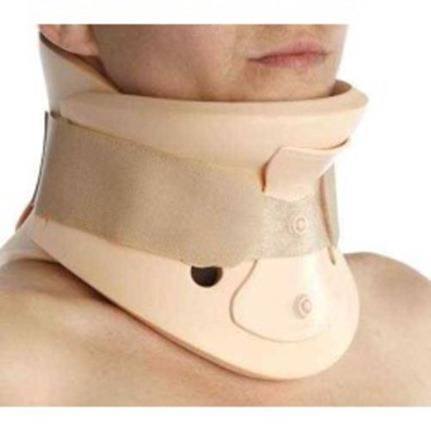Whiplash: symptoms and treatment
The whiplash or cervical sprain is an injury to the neck, usually caused by a traffic accident. It is not something serious, but it should be treated appropriately so that below, we tell you all about the Whiplash: symptoms and treatment.

What is whiplash?
Whiplash is a traumatic event that affects the cervical spine, which is the upper part of the spine. It occurs as a result of a sudden movement of the head, with transmission of sudden forces of variable intensity in one or more directions : the neck bends sharply backwards (hyperextension) of the neck), then forward (to the hyper-flexion compression), for an acceleration-deceleration reaction. A similar traumatic stress is often a consequence of car accidents (especially rear-end collisions), sports injuries, physical violence (for example, blows) or accidental falls.

In case of whiplash due to a car accident, an impact to only 15 kilometers per hour can produce this type of injury. The acceleration and deceleration received affects mainly the soft tissues tendons, muscles and ligaments.
Around 80% of whiplash injuries recover within a few months . However, around 15-20% (approximately 40,000 cases per year) develop "late whiplash injury syndrome". This syndrome includes complaints that include neck pain, headache, dizziness, hearing loss and tinnitus.
Types of whiplash

The whiplash or cervical sprain type 1
In this case the soft tissue torsion has been very small, can have slight discomfort, even slight swelling of the affected area but in a couple of days it improves and the person feels well.
Whiplash or cervical sprain type 2
In this case the twisting of the tissues has been of medium degree, there may be a break even partially, the patient complains of muscle stiffness and constant pain. There is swelling in the area that usually disappears in 48 hours. The recovery can take between 15 days and a month depending on the case.
The whiplash or cervical sprain type 3
It is the In a more serious case, the acceleration/deceleration movement to which the neck has been subjected has achieved a break with tissue separation. The person even feels that something has been broken (a feeling that something is hurting and twisting).
There is muscle stiffness and the pain is intense and goes on more as the days go by. . There is inflammation and the person is affected to carry on their daily life.Sometimes, lesions or tensions in the delicate nerves of the neck can block the signals between the brain and the body, which produces a tingling or uncomfortable numbness in the arms.
Weakness
Weakness is a symptom that appears in the long run. Due to the whiplash, patients are barely able to move the neck and shoulder area, so they lose strength in it and feel weaker. In this way, many people turn to physiotherapists to recover from this muscle weakness.
Visual alterations
It is not a symptom too common, but some experimental whiplash patients blurred vision after the impact and even hours later do not see quite well. It is something that happens with the hours although doctors have tried to find a scientific explanation and studies are still being done about it.
Ringing in the ears (tinnitus)
In a whiplash injury, the trunk suddenly projects forward and the head, due to its inertia, is thrown violently backwards (unless there is an adequate headrest). Therefore, a hyperextension of the head in the neck occurs. When the maximum extension is reached, the movement becomes a forward movement or hyperflexion. Both hyperextension and hyperflexion are conditions in which the movement of the head and neck is beyond their normal range of motion. In the hyperextension phase, the jaw opens and lengthens the temporomandibular joint (TMJ). In the hyperflexion phase, a sudden closure of the mouth occurs and the temporomandibular joint is compressed causing a misalignment that can also affect the ears, so that we may suffer for hours and even days, of a buzzing also known as tinnitus.
On the other hand, in cases that are more severe and chronic and that result in the whiplash-associated disorder, the Symptoms may include:
- depression
- anger
- frustration
- anxiety
- stress
- drug dependence
- post-traumatic stress syndrome
- sleep disturbance (insomnia)
Diagnosis of the whiplash
This type of trauma requires a immediate medical examination to assess the severity of the injuries. Investigations may also include l to execution of X-rays and TAC .

If after whiplash, the pain is very intense and there is no possible movement, it is necessary to use the orthopedic collar or collar strong> for about 15 days. The collar is possible to put it also at the same time of having suffered the accident (in the case of occurring by car accident) in this way the neck is stabilized and any subsequent neurological damage is avoided. Then in consultation the doctor removes the collar and will proceed to review the affected area.In a recent study, twenty-seven patients received acupuncture and were compared to a control group that used nonsteroidal anti-inflammatory drugs. The results showed a high percentage of positive results on the medication
Consequences of the whiplash
If we imagine the neck as a stabilized structure by a thick network of elastic bands, we can easily understand what the origins and consequences of whiplash are.

When the network experiences a strong acceleration, the resistance limit of the elastics is exceeded and the individual fibers fray more and more until they completely break ( muscle tear).
Fortunately, in most cases, the whiplash is not so violent as to cause a rupture strong> muscle fibers.
In whiplash c Characteristic, there is only a simple stretching of the cervicobucale muscles and ligaments. In addition, our body has the ability to regenerate damaged tissues even if they never reach the level of effectiveness of the originals.
Of course, some people with whiplash and experience chronic pain or pain of head for years after his accident. Doctors can trace this pain to damaged joints, discs and ligaments in the neck. But chronic pain after a whiplash injury usually has no medical explanation.
Compensation for whiplash
The vast majority of times when a whiplash occurs, this is due to a traffic accident, so patients are usually compensated by the insurance company on duty.
p> 
If the type 1 whiplash injuries are appropriate or 2 that do not leave sequels, can have an indemnification that ranges between 3,000 and 4,000 €. In cases where there are sequelae depending on the severity of these the compensation can be between 6,000 € and 17,000 (this in case the injury causes a permanent partial disability).


